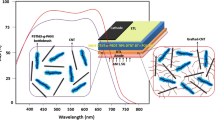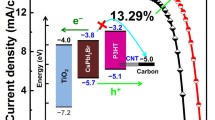Abstract
A new p-type electrode buffer layer (EBL) material was developed by the networks composed of multi-walled CNTs (MWCNTs) and poly(3-thiophene ethanol) (P3ThEt)-g-polyaniline (PANI) bottlebrush copolymers. The nanocomposites of CNT:P3ThEt-g-PANI were prepared in three different thicknesses (5, 15, and 25 nm) and employed as hole transport layer (HTL) in poly(3-hexylthiophene) (P3HT):phenyl-C71-butyric acid methyl ester (PC71BM) solar cells. A trade-off was detected between the sheet resistance and transmittance by elevating the HTL thickness for both pure CNT and CNT:P3ThEt-g-PANI nanocomposites. The CNT:P3ThEt-g-PANI thin films, in particular with an optimal thickness of 15 nm, were the turning points for equilibrating the film thickness, transmittance, surface roughness, and sheet resistance values. The smoothest thin films of CNT:P3ThEt-g-PANI with the thickness of 15 nm, the transmittance of 85–89%, and the sheet resistance of 5.6 × 104 Ω/sq reflected the best results of 12.85 mA/cm2, 60.7%, and 0.68 V. Hence, a maximum power conversion efficiency (PCE) of 5.30% was acquired among all solar cells fabricated in current work. After peaking at 15 nm, the second group of proper results was recognized in CNT:P3ThEt-g-PANI (25 nm)/P3HT:PC71BM photovoltaics (10.37 mA/cm2, 49.0%, and 0.62 V). The PCE of 3.15% for this system was even greater than the ideal performance (= 2.94%) detected in the pure CNT (15 nm)/P3HT:PC71BM solar cells.





Similar content being viewed by others
Change history
28 September 2022
This article has been retracted. Please see the Retraction Notice for more detail: https://doi.org/10.1007/s10854-022-09189-3
References
Z. He, C. Zhong, S. Su, M. Xu, H. Wu, Y. Cao, Enhanced power-conversion efficiency in polymer solar cells using an inverted device structure. Nat. Photonics 6(9), 591–595 (2012)
T. Yang, M. Wang, C. Duan, X. Hu, L. Huang, J. Peng, F. Huang, X. Gong, Inverted polymer solar cells with 84% efficiency by conjugated polyelectrolyte. Energy Environ. Sci. 5(8), 8208–8214 (2012)
S. Liu, K. Zhang, J. Lu, J. Zhang, H.L. Yip, F. Huang, Y. Cao, High-efficiency polymer solar cells via the incorporation of an amino-functionalized conjugated metallopolymer as a cathode interlayer. J. Am. Chem. Soc. 135(41), 15326–15329 (2013)
K. Li, Z. Li, K. Feng, X. Xu, L. Wang, Q. Peng, Development of large band-gap conjugated copolymers for efficient regular single and tandem organic solar cells. J. Am. Chem. Soc. 135(36), 13549–13557 (2013)
X. Guo, M. Zhang, W. Ma, L. Ye, S. Zhang, S. Liu, H. Ade, F. Huang, J. Hou, Enhanced photovoltaic performance by modulating surface composition in bulk heterojunction polymer solar cells based on PBDTTT-C-T/PC71BM. Adv. Mater. 26(24), 4043–4049 (2014)
Y. Zhou, C. Fuentes-Hernandez, J.W. Shim, T.M. Khan, B. Kippelen, High performance polymeric charge recombination layer for organic tandem solar cells. Energy Environ. Sci. 5(12), 9827–9832 (2012)
S.H. Liao, H.J. Jhuo, Y.S. Cheng, S.A. Chen, Fullerene derivative-doped zinc oxide nanofilm as the cathode of inverted polymer solar cells with low-bandgap polymer (PTB7-Th) for high performance. Adv. Mater. 25(34), 4766–4771 (2013)
C.Y. Chang, L. Zuo, H.L. Yip, Y. Li, C.Z. Li, C.S. Hsu, Y.J. Cheng, H. Chen, A.K.Y. Jen, A versatile fluoro-containing low-bandgap polymer for efficient semitransparent and tandem polymer solar cells. Adv. Funct. Mater. 23(40), 5084–5090 (2013)
Y. Sun, S.C. Chien, H.L. Yip, Y. Zhang, K.S. Chen, D.F. Zeigler, F.C. Chen, B. Lin, A.K.Y. Jen, Chemically doped and cross-linked hole-transporting materials as an efficient anode buffer layer for polymer solar cells. Chem. Mater. 23(22), 5006–5015 (2011)
Y.M. Chang, R. Zhu, E. Richard, C.C. Chen, G. Li, Y. Yang, Electrostatic self-assembly conjugated polyelectrolyte-surfactant complex as an interlayer for high performance polymer solar cells. Adv. Funct. Mater. 22(15), 3284–3289 (2012)
C. Gu, Y. Chen, Z. Zhang, S. Xue, S. Sun, K. Zhang, C. Zhong, H. Zhang, Y. Pan, Y. Lv, Y. Yang, Electrochemical route to fabricate film-like conjugated microporous polymers and application for organic electronics. Adv. Mater. 25(25), 3443–3448 (2013)
H. Zhou, Y. Zhang, C.K. Mai, S.D. Collins, T.Q. Nguyen, G.C. Bazan, A.J. Heeger, Conductive conjugated polyelectrolyte as hole-transporting layer for organic bulk heterojunction solar cells. Adv. Mater. 26(5), 780–785 (2014)
C. Xu, J. Wang, Q. An, X. Ma, Z. Hu, J. Gao, J. Zhang, F. Zhang, Ternary small molecules organic photovoltaics exhibiting 12.84% efficiency. Nano Energy (2019). https://doi.org/10.1016/j.nanoen.2019.104119
Z. Hu, F. Zhang, Q. An, M. Zhang, X. Ma, J. Wang, J. Zhang, J. Wang, Ternary nonfullerene polymer solar cells with a power conversion efficiency of 11.6% by inheriting the advantages of binary cells. ACS Energy Lett. 3(3), 555–561 (2018)
X. Ma, M. Luo, W. Gao, J. Yuan, Q. An, M. Zhang, Z. Hu, J. Gao, J. Wang, Y. Zou, C. Yang, Achieving 14.11% efficiency of ternary polymer solar cells by simultaneously optimizing photon harvesting and exciton distribution. J. Mater. Chem. A 7(13), 7843–7851 (2019)
M. Zhang, Z. Xiao, W. Gao, Q. Liu, K. Jin, W. Wang, Y. Mi, Q. An, X. Ma, X. Liu, C. Yang, Over 13% efficiency ternary nonfullerene polymer solar cells with tilted up absorption edge by incorporating a medium bandgap acceptor. Adv. Energy Mater. 8(30), 1801968 (2018)
J. You, L. Dou, K. Yoshimura, T. Kato, K. Ohya, T. Moriarty, K. Emery, C.C. Chen, J. Gao, G. Li, Y. Yang, A polymer tandem solar cell with 10.6% power conversion efficiency. Nat. Commun. 4, 1446 (2013)
F. Zhang, M. Ceder, O. Inganäs, Enhancing the photovoltage of polymer solar cells by using a modified cathode. Adv. Mater. 19(14), 1835–1838 (2007)
C.J. Brabec, S.E. Shaheen, C. Winder, N.S. Sariciftci, P. Denk, Effect of LiF/metal electrodes on the performance of plastic solar cells. Appl. Phys. Lett. 80(7), 1288–1290 (2002)
P. Peumans, S.R. Forrest, Very-high-efficiency double-heterostructure copper phthalocyanine/C 60 photovoltaic cells. Appl. Phys. Lett. 79(1), 126–128 (2001)
S.A. Carter, M. Angelopoulos, S. Karg, P.J. Brock, J.C. Scott, Polymeric anodes for improved polymer light-emitting diode performance. Appl. Phys. Lett. 70(16), 2067–2069 (1997)
T.M. Brown, J.S. Kim, R.H. Friend, F. Cacialli, R. Daik, W.J. Feast, Built-in field electroabsorption spectroscopy of polymer light-emitting diodes incorporating a doped poly (3, 4-ethylene dioxythiophene) hole injection layer. Appl. Phys. Lett. 75(12), 1679–1681 (1999)
S. Khodabakhsh, B.M. Sanderson, J. Nelson, T.S. Jones, Using self-assembling dipole molecules to improve charge collection in molecular solar cells. Adv. Funct. Mater. 16(1), 95–100 (2006)
H. Yan, P. Lee, N.R. Armstrong, A. Graham, G.A. Evmenenko, P. Dutta, T.J. Marks, High-performance hole-transport layers for polymer light-emitting diodes. Implementation of organosiloxane cross-linking chemistry in polymeric electroluminescent devices. J. Am. Chem. Soc. 127(9), 3172–3183 (2005)
J. Van De Lagemaat, T.M. Barnes, G. Rumbles, S.E. Shaheen, T.J. Coutts, C. Weeks, I. Levitsky, J. Peltola, P. Glatkowski, Organic solar cells with carbon nanotubes replacing In2O3: Sn as the transparent electrode. Appl. Phys. Lett. 88(23), 233503(1-5) (2006)
K. Norrman, M.V. Madsen, S.A. Gevorgyan, F.C. Krebs, Degradation patterns in water and oxygen of an inverted polymer solar cell. J. Am. Chem. Soc. 132(47), 16883–16892 (2010)
A.W. Hains, T.J. Marks, High-efficiency hole extraction/electron-blocking layer to replace poly (3, 4-ethylenedioxythiophene): poly (styrene sulfonate) in bulk-heterojunction polymer solar cells. Appl. Phys. Lett. 92(2), 023504(1–3) (2008)
M. Kemerink, S. Timpanaro, M.M. De Kok, E.A. Meulenkamp, F.J. Touwslager, Three-dimensional inhomogeneities in PEDOT: PSS films. J. Phys. Chem. B 108(49), 18820–18825 (2004)
L.M. Chen, Z. Xu, Z. Hong, Y. Yang, Interface investigation and engineering–achieving high performance polymer photovoltaic devices. J. Mater. Chem. 20(13), 2575–2598 (2010)
M.S. White, D.C. Olson, S.E. Shaheen, N. Kopidakis, D.S. Ginley, Inverted bulk-heterojunction organic photovoltaic device using a solution-derived ZnO underlayer. Appl. Phys. Lett. 89(14), 143517(1–3) (2006)
S.K. Hau, H.L. Yip, N.S. Baek, J. Zou, K. O’Malley, A.K.Y. Jen, Air-stable inverted flexible polymer solar cells using zinc oxide nanoparticles as an electron selective layer. Appl. Phys. Lett. 92(25), 225 (2008)
J.W. Jung, J.U. Lee, W.H. Jo, High-efficiency polymer solar cells with water-soluble and self-doped conducting polyaniline graft copolymer as hole transport layer. J. Phys. Chem. C 114(1), 633–637 (2009)
W.J. Bae, K.H. Kim, Y.H. Park, W.H. Jo, A novel water-soluble and self-doped conducting polyaniline graft copolymer. Chem. Commun. 22, 2768–2769 (2003)
W.J. Bae, K.H. Kim, W.H. Jo, Y.H. Park, A water-soluble and self-doped conducting polypyrrole graft copolymer. Macromolecules 38(4), 1044–1047 (2005)
W.J. Ke, G.H. Lin, C.P. Hsu, C.M. Chen, Y.S. Cheng, T.H. Jen, S.A. Chen, Solution processable self-doped polyaniline as hole transport layer for inverted polymer solar cells. J. Mater. Chem. 21(35), 13483–13489 (2011)
W. Zhao, L. Ye, S. Zhang, B. Fan, M. Sun, J. Hou, Ultrathin polyaniline-based buffer layer for highly efficient polymer solar cells with wide applicability. Sci. Rep. 4, 6570 (2014)
E. Kymakis, M.M. Stylianakis, G.D. Spyropoulos, E. Stratakis, E. Koudoumas, C. Fotakis, Spin coated carbon nanotubes as the hole transport layer in organic photovoltaics. Sol. Energy Mater. Sol. Cells 96, 298–301 (2012)
R. Sarvari, M. Akbari-Alanjaraghi, B. Massoumi, Y. Beygi-Khosrowshahi, S. Agbolaghi, Conductive and biodegradable scaffolds based on a five-arm and functionalized star-like polyaniline–polycaprolactone copolymer with ad-glucose core. New J. Chem. 41(14), 6371–6384 (2017)
B. Massoumi, R. Sarvari, S. Agbolaghi, Biodegradable and conductive hyperbranched terpolymers based on aliphatic polyester, poly (D, L-lactide), and polyaniline used as scaffold in tissue engineering. Int. J. Polym. Mater. Polym. Biomater. 67(13), 808–821 (2018)
M. Zhang, F. Zhang, Q. An, Q. Sun, W. Wang, X. Ma, J. Zhang, W. Tang, Nematic liquid crystal materials as a morphology regulator for ternary small molecule solar cells with power conversion efficiency exceeding 10%. J. Mater. Chem. A 5(7), 3589–3598 (2017)
M. Zhang, F. Zhang, Q. An, Q. Sun, W. Wang, J. Zhang, W. Tang, Highly efficient ternary polymer solar cells by optimizing photon harvesting and charge carrier transport. Nano Energy 22, 241–254 (2016)
Q. An, F. Zhang, Q. Sun, M. Zhang, J. Zhang, W. Tang, X. Yin, Z. Deng, Efficient organic ternary solar cells with the third component as energy acceptor. Nano Energy 26, 180–191 (2016)
Z. Hu, Z. Wang, Q. An, F. Zhang, Semitransparent polymer solar cells with 12.37% efficiency and 18.6% average visible transmittance. Sci. Bull. (2019). https://doi.org/10.1016/j.scib.2019.09.016
Acknowledgments
We express our gratitude to the Payame Noor University as well as Azarbaijan Shahid Madani University for their cooperation.
Author information
Authors and Affiliations
Corresponding authors
Additional information
Publisher's Note
Springer Nature remains neutral with regard to jurisdictional claims in published maps and institutional affiliations.
This article has been retracted. Please see the retraction notice for more detail: https://doi.org/10.1007/s10854-022-09189-3"
Electronic supplementary material
Below is the link to the electronic supplementary material.
Rights and permissions
Springer Nature or its licensor holds exclusive rights to this article under a publishing agreement with the author(s) or other rightsholder(s); author self-archiving of the accepted manuscript version of this article is solely governed by the terms of such publishing agreement and applicable law.
About this article
Cite this article
Sorkhishams, N., Massoumi, B., Saraei, M. et al. RETRACTED ARTICLE: Electrode buffer layers via networks of polythiophene/polyaniline bottlebrushes and carbon nanotubes in organic solar cells. J Mater Sci: Mater Electron 30, 21117–21125 (2019). https://doi.org/10.1007/s10854-019-02482-8
Received:
Accepted:
Published:
Issue Date:
DOI: https://doi.org/10.1007/s10854-019-02482-8




